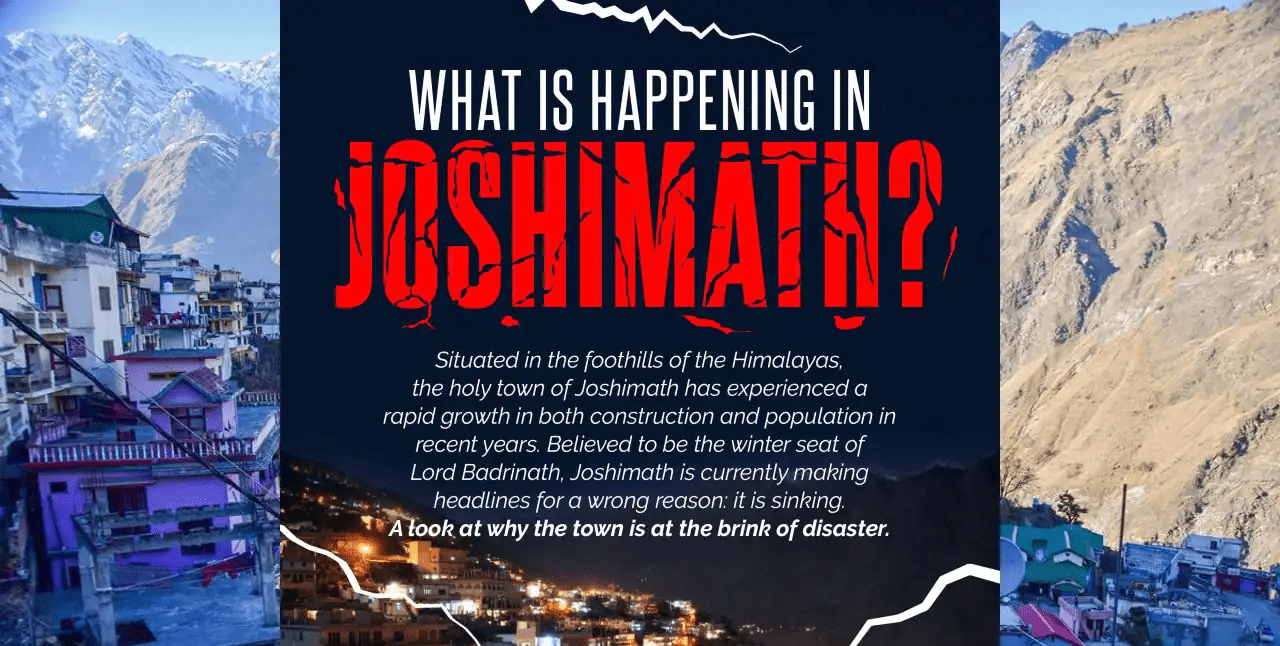Crisis in the Himalayas: Joshimath, also known as Jyotirmath, is a municipality and temple town in the Chamoli district of Uttarakhand.
The Joshimath tragedy in Uttarakhand indicates the larger crisis in the Hindu Kush Himalayan (HKH) region. Uninhibited tourism in this ecologically sensitive area has also put tremendous pressure on the environment.
One of the four cardinal institutions established by Adi Shankaracharya in each of India’s four corners is the maths or monastery. One of the cantonments closest to the China border is that at Joshimath. The town thus has strategic and religious importance.
What is the Crisis in the Himalayas?
Joshimath, a town in the Himalayas, is under a great deal of strain, and some of it has begun to sink. The underlying problem has always been how development is carried out without attention to environmental sustainability.
An individual project’s environmental impact assessment does not account for the cumulative effects of a number of similar projects in a river basin.
The twin demands of religion and defence have recently been added to the case for progress. This disregarded factors related to the environment and the terrain.

What has led to this Crisis in the Himalayas?
Chamoli disaster: In February 2021, the Rishiganga and Dhaulganga rivers experienced flash floods as a result of the glacial landslide known as the Chamoli disaster. The Ganga receives water from the two rivers.
Around 200 individuals perished in the catastrophe, including workmen who became trapped in the tunnel of the Tapovan Vishnugad hydropower facility on the Dhaulganga river.
Heavy downpours, cloudbursts, rock falls, debris flows, avalanches, floods, and flash floods occurred in numerous sites throughout the state, according to the Uttarakhand State Disaster Management Authority. The land in Chamba, Himachal Pradesh, began to sag shortly after a hydroelectric power project began test runs in the region.
Heavy rains in Aizawl triggered subsidence, exposing poor zoning enforcement and oversight of the regional carrying capacity.
According to the research, the main causes of this Crisis in the Himalayas are:
a) changes in the weather regime;
b) aberrant rainfall patterns; and
c) careless human behaviour in high-risk locations.
Findings of MC Mishra committee: In 1964, the government appointed the MC Mishra committee to find out why Joshimath was sinking.
The committee found that:
a) Joshimath is situated in an old landslide zone,
b) Joshimath could sink if rampant development is unchecked.
The committee suggested that Joshimath’s immediate surroundings should be off-limits to major construction.
Numerous hydropower projects, including the Vishnugad hydroelectric plant, have been allowed in places like Joshimath and Tapovan despite the geological and environmental sensitivity of the area.
Two private researchers discovered in 2010 that the tunnelling procedure in projects punctures the strata that contain water, resulting in damage from water spilling out and flooding the area.
Protect the Himalayan ecosystem?
Hydro projects in the Himalayan region should typically be run-of-the-river in nature since large-scale water storage reservoirs can significantly upset a seismically unstable and still-moving environment.
Six-lane highways should not be built to important pilgrimage sites high in the Himalayas in order to respect religious sensibilities. Similar to this, for defence, short-term gains in access should not be at the expense of long-term communications disruptions brought on by disasters.
There is a pressing need for multidisciplinary expert teams to conduct a thorough survey. This is done in order to comprehend the scope and nature of the environmental crisis in the Himalayas. The disturbing tendencies that are escalating day by day must be stopped by the government, and then they must be reversed.
.
Read More Articles on Current Affairs
Follow on Youtube – Score Better
Join Us on Telegram For More Updates
.
Why is Joshimath sinking?
On its vulnerable slopes, which experts claim was created from the detritus of previous landslides and are therefore susceptible to subsidence, unchecked development proliferated. The slopes in the area have become weaker as a result of the enormous drilling and excavating that was done there using explosives to build highways, dams, and other structures.
What is the altitude of Joshimath?
Joshimath often spelt Jyotirmath, is a municipality and a city in the Uttarakhand state of India’s Chamoli District. It is a gateway to several Himalayan mountain climbing adventures, hiking paths, and pilgrimage sites like Badrinath and is situated at a height of 6150 feet (1875 m).
Why is Joshimath famous?
Joshimath is renowned for being the starting point for mountain climbing adventures, trekking, and a number of other exhilarating pursuits for people seeking an adventurous lifestyle. One must go from here to the popular trekking location in Uttarakhand, the Valley of Flowers.
Why it is called Joshimath?
The ancient texts refer to Joshimath as Kartikeyapura because Kartikeya, the god of Katyuri kings, was the inspiration for its naming. Lord Badri, who is carried from Badrinath to the Vasudeva temple in Joshimath during the winter, settles in the town.
